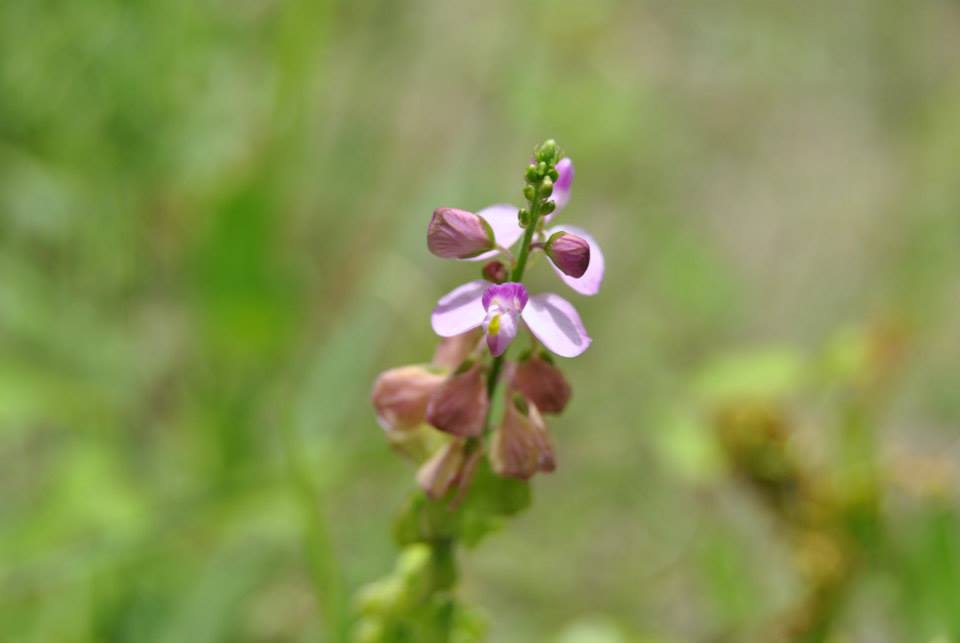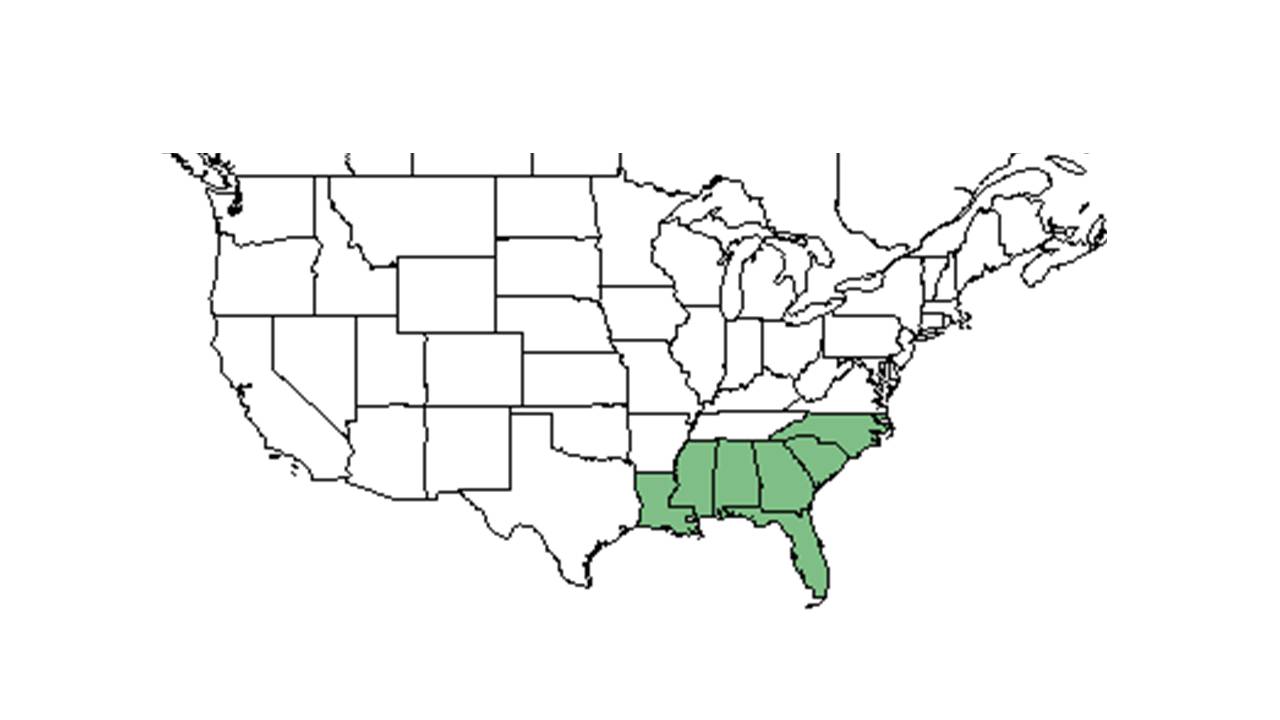Asemeia grandiflora
| Asemeia grandiflora | |
|---|---|

| |
| Photo taken by Michelle M. Smith | |
| Scientific classification | |
| Kingdom: | Plantae |
| Division: | Magnoliophyta – Flowering plants |
| Class: | Magnoliopsida – Dicotyledons |
| Order: | Polygalales |
| Family: | Polygalaceae |
| Genus: | Asemeia |
| Species: | A. grandiflora |
| Binomial name | |
| Asemeia grandiflora Walter | |

| |
| Natural range of Asemeia grandiflora from USDA NRCS Plants Database. | |
Common name: showy milkwort
Contents
Taxonomic notes
Synonyms: Polygala grandiflora[1]
Varieties: Asemeia cumulicola Small; Asemeia grandiflora var. angustifolia; A. grandiflora (Walter) Small var. grandiflora; A. leiodes (Blake) Small; Asemeia miamiensis Small; Polygala corallicola Small; Polygala grandiflora Walter var. grandiflora[1]
The taxonomic history behind the Asemeia genus which previously was under the Polygala genus and is still under the Polgalaceae family. Asemeia grandiflora was previously Polygala grandiflora but since has changed in 2012. More information can be found in their paper, Taxonomic notes and new combinations for Asemeia (Polygalaceae). [2]
Description
This description of Asemeia grandiflora comes from Radford (1964) which recognized A. grandiflora as a synonym of Polygala grandiflora.
A. grandiflora is a perennial herb with appressed or spreading pubescent stems that grow to approximately 25 - 50 cm tall. The leaves are alternate and oblanceolate to linear-oblanceolate, and are rarely elliptic. The leaves are 1.5 - 5 cm long, and 2 - 17 mm wide, and are somewhat pubescent underneath, especially on the veins. The racemes are 5 - 17 cm long. The sepals are green in color, are 1.5 - 2 mm long. The wings are pink in color with green veins and orbicular to reniform, and 5 - 7 mm long tapered to claws. The flower is shorter than the wings and is not lacerate the apex. There are 8 stamens. The seeds are black in color, are densely pubescent, and are approximately ca. 2 mm long. The aril is 3-lobed where the lobes do not extend up and around the seed body.[3]
Distribution
It is native to the Southeast United States, ranging from Louisiana to North Carolina.[4]
Ecology
Habitat
A. grandiflora has been found growing within calcareous glades, upland pine woods, longleaf pine-scrub oak sand ridges, savannas, and sandhill communities.[5][6] It has also been observed growing in swales of slash pine plantations. A. grandiflora has been found to be a decreaser in its long-term response following cessation of repeated soil disturbance.[7]
Phenology
This species has been observed flowering and fruiting in May[6] to July[3]; however, it is noted that A. grandiflora flowers in southern Florida all year round and the rest of Florida from March to August.[8]
Seed dispersal
This species is thought to be dispersed by explosion mechanisms or by ants. [9]
Fire ecology
Asemeia grandiflora has been observed to flower within two months of burning in early summer.[10]
Herbivory and toxicology
Asemeia grandiflora has been observed at the Archbold Biological Station to host leafcutting bees such as Anthidiellum notatum rufomaculatum (family Megachilidae).[11]
Conservation, cultivation, and restoration
Cultural use
Photo Gallery
References and notes
- ↑ 1.0 1.1 Weakley, A.S. 2020. Flora of the Southeastern United States. Edition of 20 October 2020. University of North Carolina at Chapel Hill, Chapel Hill, North Carolina.
- ↑ Pastore, J.F.B & J.R. Abbott (2012). "Taxonomic notes and new combination for Asemeia (Polygalaceae)." Kew Bulletin. (Vol 67 Issue 4 Pg. 801-13).
- ↑ 3.0 3.1 Radford, Albert E., Harry E. Ahles, and C. Ritchie Bell. Manual of the Vascular Flora of the Carolinas. 1964, 1968. The University of North Carolina Press. 655-6. Print.
- ↑ USDA, NRCS. (2016). The PLANTS Database (http://plants.usda.gov, 22 Marh 2019). National Plant Data Team, Greensboro, NC 27401-4901 USA.
- ↑ Deyrup, M. J. E., and Beth Norden (2002). "The diversity and floral hosts of bees at the Archbold Biological Station, Florida (Hymenoptera: Apoidea)." Insecta mundi 16(1-3).
- ↑ 6.0 6.1 Florida State University Robert K. Godfrey Herbarium database. URL: http://herbarium.bio.fsu.edu. Last accessed: June 2014. Collectors: Ann F. Johnson, Wilson Baker, Roy Komarek, R. A. Norris, Robert K. Godfrey, A. Gholson Jr., Chris Cooksey, Kevin Oakes, and Lisa Keppner. States and Counties: Florida: Calhoun, Gadsden, Jackson, Leon, Sarasota, Wakulla, and Washington. Georgia: Grady and Thomas.
- ↑ Dixon, C. M., K. M. Robertson, A. M. Reid and M. T. Rother. 2024. Mechanical soil disturbance in a pine savanna has multiyear effects on plant species composition. Ecosphere 15(2):e4759.
- ↑ Nauman, Clifton E. (1981). "Polygala grandiflora (Polygalaceae) Walter Re-examined." Sida 9(1): 1-18.
- ↑ Kirkman, L. Katherine. Unpublished database of seed dispersal mode of plants found in Coastal Plain longleaf pine-grasslands of the Jones Ecological Research Center, Georgia.
- ↑ Robertson, Kevin M. 2014. Personal observation at Pebble Hill Plantation, Grady County, GA.
- ↑ Deyrup, M.A. and N.D. 2015. Database of observations of Hymenoptera visitations to flowers of plants on Archbold Biological Station, Florida, USA.